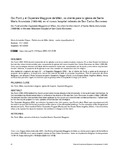Mostrar o rexistro simple do ítem
Gio Ponti y el Ospedale Maggiore de Milán, su cliente para la iglesia de Santa María Anunciata (1963-66) en el nuevo hospital milanés de San Carlos Borromeo
| dc.contributor.author | Crippa, Maria Antonietta | |
| dc.date.accessioned | 2024-04-03T18:29:56Z | |
| dc.date.available | 2024-04-03T18:29:56Z | |
| dc.date.issued | 2023-12-16 | |
| dc.identifier.citation | Crippa, Maria Antonietta. 2023. «Gio Ponti y el Ospedale Maggiore de Milán, su cliente para la iglesia de Santa María Anunciata (1963-66) en el nuevo hospital milanés de San Carlos Borromeo». Actas de Arquitectura Religiosa Contemporánea10: 64-79. https://doi.org/10.17979/aarc.2023.10.0.10182 | es_ES |
| dc.identifier.issn | e-ISSN 2659-8671 | |
| dc.identifier.uri | http://hdl.handle.net/2183/36061 | |
| dc.description.abstract | [Resumen] Gio Ponti (1891-1979) abordó el proyecto de las iglesias cuando ya estaba en plena madurez. En su libro Amate l’architettura formulò dos ideas fundamentales para comprender la iglesia del nuevo hospital San Carlos Borromeo de Milán (1963-66). Creía que la antigua relación individual cliente-arquitecto había sido reemplazada por la social y más íntima arquitectura-función. Además, el proyecto de la iglesia no era una cuestión de arquitectura sino de religión.Una institución originaria del siglo XV —el Ospedale Maggiore (OM)— fue el cliente de Ponti, a quien se le encargó el proyecto de la iglesia y la inspección formal del exterior de todo el complejo hospitalario. Para la ejecución de obras litúrgicas y de devoción, Ponti involucró al padre Costantino Ruggeri (Pavia) y a la Escuela Beato Angélico (Milàn). Varios archivos nos permiten captar la dinámica que se produjo entre el arquitecto a cargo y el cliente. | es_ES |
| dc.description.abstract | [Abstract] Gio Ponti (1891-1979) tackled the church project when he was already in the full maturity. In his book Amate l’architettura, hehad formulated two fundamental ideas to understand the church of the new San Carlo Borromeo hospital in Milan (1963-66). He believed that the client-architect has been replaced by the social and more intimate architecture-function. Furthermore, for him the church project it is not a question of architecture but of religion.The Ospedale Maggiore (OM), an institution founded in the 15th century, was Ponti’s client. Ponti was commissioned with the church project and the formal inspection of the exterior of the all hospital buildings. For the execution of the liturgical and devotional works, Ponti involved Father Costantino Ruggeri (Pavia) and the Scuola Beato Angélico (Milan). A lot of archives allow us to capture the dynamic between the architect in charge and the client | es_ES |
| dc.language.iso | spa | es_ES |
| dc.publisher | Universidade da Coruña, Servizo de Publicacións | es_ES |
| dc.relation.uri | https://doi.org/10.17979/aarc.2023.10.0.10182 | es_ES |
| dc.rights | Atribución-NoComercial 4.0 Internacional | es_ES |
| dc.rights.uri | https://creativecommons.org/licenses/by-nc/4.0/deed.es | * |
| dc.subject | Gio Ponti | es_ES |
| dc.subject | Milán | es_ES |
| dc.subject | Arquitectura religiosa | es_ES |
| dc.subject | Iglesia de hospital | es_ES |
| dc.subject | Ospedale Maggiore | es_ES |
| dc.subject | Sacred architecture | es_ES |
| dc.subject | Hospital church | es_ES |
| dc.subject | Arquitectura relixiosa | es_ES |
| dc.subject | Igrexa de hospital | es_ES |
| dc.title | Gio Ponti y el Ospedale Maggiore de Milán, su cliente para la iglesia de Santa María Anunciata (1963-66) en el nuevo hospital milanés de San Carlos Borromeo | es_ES |
| dc.title.alternative | Gio Ponti and the Ospedale Maggiore of Milan, his client for the church of Santa Maria Annunciata (1963-66) in the new Milanese Hospital of San Carlo Borromeo | es_ES |
| dc.type | info:eu-repo/semantics/article | es_ES |
| dc.rights.access | info:eu-repo/semantics/openAccess | es_ES |
| UDC.journalTitle | Actas de Arquitectura Religiosa Contemporánea | es_ES |
| UDC.volume | 10 | es_ES |
| UDC.startPage | 64 | es_ES |
| UDC.endPage | 78 | es_ES |






